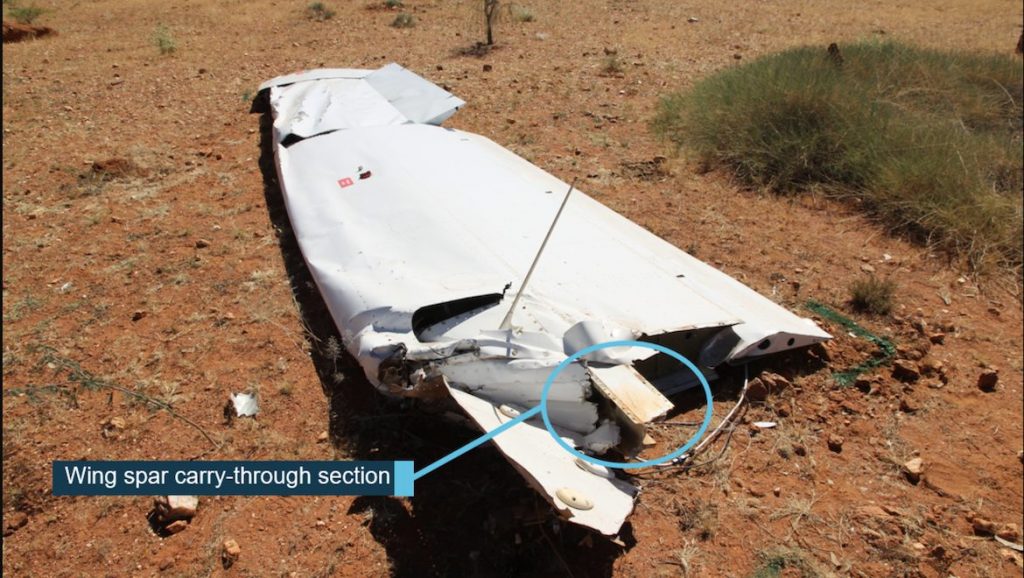
Australia’s transport safety investigator has urged the manufacturer of Cessna 210 aircraft, Textron Aviation, to address structural fatigue concerns after an in-flight breakup occurred in May 2019.
The Australian Transport Safety Bureau (ATSB) has said it made a formal recommendation to Textron “to further address the risk of fatigue cracking within the aircraft’s carry-through structure”, particularly during low-level survey operations.
The recommendation was made amid the release of the ATSB’s final report into an incident that occurred on 26 May 2019, when a Cessna T210M collided with terrain while conducting low-level geographical survey work near Mount Isa in Queensland, after its right wing separated in-flight.
The aircraft, VH-SUX, took off from Mount Isa airport on the afternoon of 26 May with a pilot and observer onboard.
Around one hour, 40 minutes later, the aircraft was flying 193 feet above ground level at a speed of 147 knots when its right wing separated, leading to a “rapid loss of control and collision with terrain”.
Both crew members were fatally injured in the crash, and the aircraft was destroyed.
After performing detailed examinations of the wreckage, the ATSB found that a “relatively minor corrosion near a highly-stressed location on the lower surface of the wing spar carry-through had progressed into the aluminium alloy structure”, which resulted in a fatigue crack in that part of the wing.
“The crack propagated to a critical size resulting in an overstress fracture of the remaining wing carry-through structure material and separation of the right wing,” the ATSB report said.
Since the incident, both Textron and the US Federal Aviation Administration have requested the operators of certain Cessna 210 and Cessna 177 aircraft to conduct inspections and communicate the results.
To-date, the FAA and Textron Aviation had received 1,119 reports from Cessna 210 owners and operators who had undertaken the visual and eddy current inspections of the carry-through spar on their aircraft.
Of these, 499 reported corrosion and 68 carry‑through structures were removed from service.
Textron has advised the ATSB that it would be undertaking a fatigue analysis of the C210 wing spar carry-through in its original configuration “to determine whether a modified inspection program or life limit is necessary”, and that it is working on a certification program to install a new spar in the C210 with an updated configuration and material.
“The ATSB acknowledges the significant safety actions taken to date by the manufacturer and regulators as a result of this accident and the ATSB’s investigation, and notes that these measures have addressed the short-term risk of further similar failures,” said ATSB chief commissioner Angus Mitchell.
“Further, the ATSB welcomes Textron’s ongoing efforts to address the risk of cracking in wing spar carry-through structure of Cessna 210 aircraft used for low-level geophysical survey operations.
“However, the ATSB remains concerned by the indefinite nature of the manufacturer’s proposed analysis and certification program and recommends that further action be taken to address this safety issue.”
In 1992, Cessna had introduced a continued airworthiness program for the Cessna 210 which included repetitive eddy current inspection for cracking of the carry-through structure. This flight-hours based inspection was more stringent for aircraft being used for low-level surveys.
Eddy current inspection is a form of non-destructive testing which can detect flaws in the internal consistency of certain types of metals.
However, following an assessment of historical data in 2011, Cessna replaced this inspection with a visual corrosion inspection, on a three-yearly frequency for all operation types, irrespective of hours flown.
“Had the previous flight-hour based eddy current inspection schedule remained in place, it is almost certain that the fatigue crack within the wing spar carry-through would have been detected before this accident occurred,” Mr Mitchell said.
The accident aircraft had accumulated 6,241 flight hours in the six years leading up to the accident and had been operated exclusively as a geophysical survey aircraft during that time. In total the aircraft had accumulated 12,175 flight hours.
As part of the investigation, the ATSB, in cooperation with the operator, undertook data gathering using an instrumented Cessna 210N to determine in-flight loads associated with the geophysical survey flight profile. Data from 95 flights over a period of 10 weeks during autumn in 2020 was sampled and analysed.
“The ATSB’s analysis showed that cyclic loads induced by the low-level survey flight profile were significantly greater than those associated with the higher-level flight profile originally intended for the aircraft type, and this probably increased the risk of a fatigue-related structural failure,” Mr Mitchell said.
“Even when flying within operational limits, if an aircraft is operated in a flight profile for which it was not originally intended, its structure can fatigue more rapidly.
“The ATSB cautions all geophysical survey aircraft operators that the terrain following flight profile may significantly increase aircraft fatigue damage accumulation.”
The investigation also determined that the airframe and system modifications incorporated into the accident aircraft did not significantly increase the fatigue damage accumulated by the wing spar carry-through structure.















